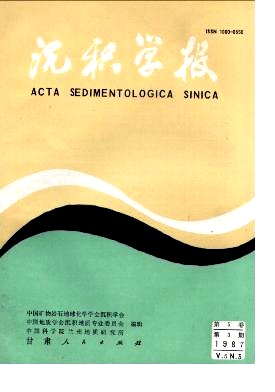SEDIMENTARY FACIES OF LATE SINIAN IN SOUTH CHINA AND THE DISTRIBUTION OF PHOSPHORITES IN TIME AND SPACE
- Publish Date: 1987-09-10
Abstract: Guangxi Sea Basin, Qin Ling Sea Basin and South Anhui-North Jiangxi Sea Basin. The slope was distributed in areas from carbonate platform to sea basin, for example , Hunan-Guizhou slope was spread between Sichuan-Guizhou-Yannan Platform and Hunan- Guangxi Basin. Distribution of phosphorites in the strata The fig.l shows that the upper Sinian strata in South China have 8 beds of phosphate-bearing rocks and phosphorites. There are 3 beds belong to Doushantuo Formation and 5 beds occurred ia Dengying Formation. The phosphorite of Doushantuo Formation: The Liujing member consists mainly of manganese-bearing micritic limestones and dolostones, 3 to 20m in thickness, widely distributed ia the Yangtze region and Western Zhejiang but in Eastera North Jiangxi, it intercalated with phosphorites. The Songlin member, 100-470m in thickness, consists chiefly of black shales, dark-grey or black limestones and marls, or in some areas. Mostly dolostones and argillaceous dolostones in which phosphorites are often intercalated. The black shale, often containing a diversity of siliceous concretions and stripe, with rich microfossils, organic matter and phosphate, are widely developed, especially in Xothern and Eastern Guizhou, Western Hunan, Hubei and Eastern-Xorthern Jiangxi Provinces. The Songlin member of Donshantuo Formation in these areas has 2 industrial ore beds of phosphorites(fig.l). Phosphorites are frequently associated with either black shales or dolostones, and occur in 2 types of depositional sequences. The first is ascendingly as follows: black shales with siliceous phosphatic concretions-→black shales with stripe and bands of interclastic phosphorites-→laminated phosphorites containing often phosphate interclasts, peloids, oncoids and stromatolites-→dolostones with phosphate bands-→dolostones with phosphate lens-→dolostones lens- dolostones (in Yichang, Hubei Province ). The second type of sequence in ascending order is argillaceous dolostones-→phosphorites-→dolostones (in Shimen, Hunan Province). The characteristic of these sequences above mentioned indicates that phosphorites in Doushantuo Formation were formed under the conditions of a warm gradually changed into an arid and a semi-arid climate, and quiet environment gradually getted to a stronger turbidity environment. The phosphorite of Dengying Formation: Although Dengying Formation has 5 beds of phosphate-bearing rocks in the Yangtze region and Western Zhejiang Province, the phosphoritic bed with industrial value occur mainly on the interruption plane between upper and lower members of Dengying Formation in Xanzhang, Hubei Province. It consists usually of phosphoritic breccias, sands, oncoids and sometimes algal laminated phosphorites, cemented mostly by dolomite, occassionally by phosphate. The types of these phosphorites will play an important role in indicating that phosphate rocks would be found at horizons of the Dengying Formation in some of other places in the Yangtze region. Regularity of the phosphorites and other mineral distribution. The upper Sinian strata in South China contain exceedingly abundant phosphorites, magnesite, manganese spars, halite, natural gas, as well as vanadium, and mercury. The most famous is the phosphorite of Doushantuo Formation They were formed under different environments and distributed within various facies belts. For example,the pure phosphorite with industrial value mainly occur in the upper part of the slope facies belt or may be formed in tidal flat of carbonate platform margins, while halite and magnesite were confined to carbonate platform lagoon facies. The algal bank facies belt is favarable for oil and gas reservoirs. The numeous blue-green algal microfossils preserved in the phosphorite and manganese carbontes stow that the occurrence of mineralization are closely related to organic reaction.
| Citation: | Tang Tianfu, Xue Yaosong, Yu Congliu. SEDIMENTARY FACIES OF LATE SINIAN IN SOUTH CHINA AND THE DISTRIBUTION OF PHOSPHORITES IN TIME AND SPACE[J]. Acta Sedimentologica Sinica, 1987, 5(3): 113-124. |






 DownLoad:
DownLoad: